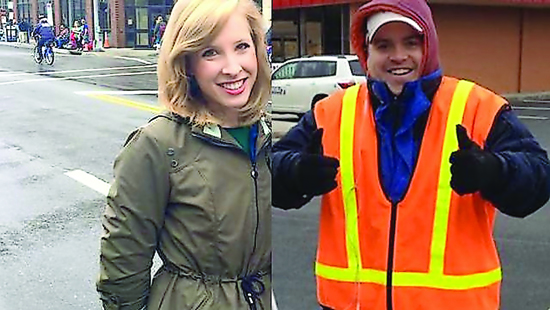
Was
Was

hington: After a day of mourning for the media, an ethics debate raged as several newspapers splashed images of the killing of two US journalists on live television from the shooter’s viewpoint.
The prominent publication of the shocking images triggered a backlash from some readers and media ethicists, claiming that their use stepped over the line of responsible journalism after the killings of reporter Alison Parker, 24, and cameraman Adam Ward, 27.
“The line is pretty clear to me. It is the moment when information becomes exploitation,” said Ken Paulson, a former USA Today editor in chief who is now dean of communications at Middle Tennessee State University.
“If a prominent celebrity were raped and you captured that on video, would you run that? I don’t think so. Why would the murder of two people be any less obscene?”
Paulson said newspapers “owe a debt to readers to respect their values and not shock or unsettle them” even though the same violent images may be available online. “If your standard is ‘Will other people tweet this?’ you have no standards whatsoever.”
On Twitter, readers expressed shock at newspapers displaying the images taken by gunman Vester Lee Flanagan, 41, including one from his perspective as he pulled the trigger.
“NY Daily News just shared a disgusting image they plan to have on cover tomorrow. Can’t imagine how anyone involved can sleep easy tonight,” tweeted Hunter Walker, a journalist at Business Insider. Freelance photographer Matthew Gregoire tweeted, “Who in their right mind would think it’s OK to print that photo?? Shame on them!!”
Responding to similar images on the cover of the British tabloid The Sun, Twitter readers wrote, comments such as “trash,” and a “disgrace to journalism”.
The news blog iMediaEthics said it was not reproducing the Daily News front page because it “crosses ethical and decency lines”. “To select photos, taken from the gunman’s view, during the last seconds of Parker’s life, clearly is beyond the pale,” the media ethics blog said. Broadcasters faced similar issues over the use of the killer’s video, which was shown on some outlets including CNN and the BBC.
Claire Wardle, research director at Columbia University’s Tow Centre for Digital Journalism, said newsrooms appear to be desensitised to violent images from several years of dissemination of images of beheadings and other violence, but that mainstream media still have a responsibility.
If news organisations use the images prominently, Wardle said, “they are saying to anyone else who is potentially unstable, ‘You will be on the front covers of newspapers’” if you commit a similar crime.
“If people want to find these images online, they can,” she said. “But mainstream media have a bigger responsibility to tell the story and make them understand what happened.”
Phil Chetwynd, editor-in-chief of Agence France-Presse, said the news agency decided to take a cautious approach to the gunman’s images and video, saying they were “effectively the killer’s propaganda statement”.
“We finally decided to send two screen grabs from the video to our clients,” Chetwynd said.
“We included the startling image of the gun being pointed at the unsuspecting journalist but we did not show any images depicting the actual shooting or its aftermath. We also did not move any video images to clients.”
But Harry Siegel, a Daily News editorial writer and columnist, said violent images should not be censored on social media or elsewhere. “After 12 years of ugly wars most Americans never saw much of ... it’s high time we stop trusting gatekeepers to decide what violence is, or isn’t, acceptable,” he wrote.
AFP




